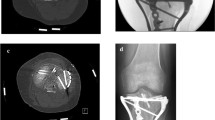Abstract
Purpose
This retrospective review follows 31 tibial nonunions to compare union at the docking site using closed versus open strategies. In this cohort of patients, all but five were infected nonunions.
Methods
Thirteen patients initially treated with single compression were compared with 18 patients treated by open revision of the docking site. In the single compression group, an average of 6.5 cm of bone was resected and index lengthening was 2.04. In the open revision group, a mean of 9.4 cm was resected and the index lengthening was 1.73.
Results
Consolidation at the docking site occurred in all subjects in both groups. There was no statistical difference between the two groups. Conclusive evidence of superiority of one modality of treatment over the other cannot be drawn from our data.
Conclusions
The simple compression procedure requires less invasive surgery and is probably less demanding and more cost-effective in short transports.




Similar content being viewed by others
References
Bumbasirević M, Tomić S, Lesić A et al (2010) War-related infected tibial nonunion with bone and soft-tissue loss treated with bone transport using the Ilizarov method. Arch Orthop Trauma Surg 130:739–749
Cattaneo R, Catagni MA, Johnson EE (1992) The treatment of infected nonunions and segmental defects of the tibia by the methods of Ilizarov. Clin Orthop Relat Res 280:143–152
Dendrinos GK, Kontos S, Lyritsis E (1995) Use of the Ilizarov technique for treatment of non-union of the tibia associated with infection. J Bone Joint Surg Am 77(6):835–846
Einhorn TA (1998) The cell and molecular biology of fracture healing. Clin Orthop Relat Res 355:S7–S21
Elbatrawy Y, Fayed M (2009) Deformity correction with an external fixator: ease of use and accuracy? Orthopedics 32:82
El-Alfy B, El-Mowafi H, El-Moghazy N (2010) Distraction osteogenesis in management of composite bone and soft tissue defects. Int Orthop 34(1):115–118
Garcia FL, Picado CH, Garcia SB (2009) Histology of the regenerate and docking site in bone transport. Arch Orthop Trauma Surg 129(4):549–558
Giotakis N, Narayan B, Nayagam S (2007) Distraction osteogenesis and nonunion of the docking site: is there an ideal treatment option? Injury 38(Suppl 1):S100–S107
Green SA (1994) Skeletal defects. A comparison of bone grafting and bone transport for segmental skeletal defects. Clin Orthop Relat Res 301:111–117
Guerreschi F, Azzam W, Camagni M et al (2010) Tetrafocal bone transport of the tibia with circular external fixation: a case report. J Bone Joint Surg Am 92:190–195
Hutson JJ Jr, Dayicioglu D, Oeltjen JC et al (2010) The treatment of Gustilo grade IIIB tibia fractures with application of antibiotic spacer, flap, and sequential distraction osteogenesis. Ann Plast Surg 64:541–552
Ilizarov GA, Ledyaev VI (1992) The replacement of long tubular bone defects by lengthening distraction osteotomy of one of the fragments. Clin Orthop Relat Res 280:7–10
Lovisetti G, Sala F, Thabet AM et al (2011) Osteocutaneous thermal necrosis of the leg salvaged by TSF/Ilizarov reconstruction. Report of 7 patients. Int Orthop 35(1):121–126
Paley D, Catagni MA, Argnani F et al (1989) Ilizarov treatment of tibial nonunions with bone loss. Clin Orthop Relat Res 241:146–165
Paley D, Maar DC (2000) Ilizarov bone transport treatment for tibial defects. J Orthop Trauma 14(2):76–85
Rozbruch SR, Pugsley JS, Fragomen T et al (2008) Repair of tibial nonunions and bone defects with the Taylor Spatial Frame. J Orthop Trauma 22:88–95
Rozbruch RS, Weitzman AM, Watson JT et al (2006) Simultaneous treatment of tibial bone and soft-tissue defects with the Ilizarov method. J Orthop Trauma 20:197–205
Sabharwal S, Green S, McCarthy J et al (2011) What’s new in limb lengthening and deformity correction. J Bone Joint Surg Am 93:213–221. doi:10.2106/JBJS.J.01420
Sala F, Marinoni E, Castelli F et al (2009) Endoscopic approach for docking site bone grafting in Taylor Spatial Frame during bone transport. Injury Extra 40:175–177. doi:10.1016/j.injury.2009.05.032
Sala F, Talamonti T, Agus MA (2011) Tetrafocal leg reconstruction using combined Ilizarov/TSF technique. Musculoskelet Surg. doi:10.1007/s12306-011-0116-9
Sala F, Thabet AM, Castelli F et al (2011) Bone transport for postinfectious segmental tibial bone defects with a combined Ilizarov/Taylor spatial frame technique. J Orthop Trauma 25(3):162–168
Saleh M, Rees A (1995) Bifocal surgery for deformity and bone loss after lower-limb fractures. Comparison of bone-transport and compression-distraction methods. J Bone Joint Surg Br 77(3):429–434
Song HR, Cho SH, Koo KH et al (1998) Tibial bone defects treated by internal bone transport using the Ilizarov method. Int Orthop 22:293–297
Uzel AP, Lemonne F, Casoli V (2010) Tibial segmental bone defect reconstruction by Ilizarov type bone transport in an induced membrane. Orthop Traumatol Surg Res 96:194–198
Acknowledgments
We thank Rasha Shaker, MD, for great care in providing excellent statistic revision of the paper.
Conflict of interest
The authors declare that they have no conflict of interest.
Author information
Authors and Affiliations
Corresponding author
Additional information
This study was approved by the Ethics Review Boards of Sant’Anna, Menaggio and Niguarda Hospitals, Italy.
Rights and permissions
About this article
Cite this article
Lovisetti, G., Sala, F., Miller, A.N. et al. Clinical reliability of closed techniques and comparison with open strategies to achieve union at the docking site. International Orthopaedics (SICOT) 36, 817–825 (2012). https://doi.org/10.1007/s00264-011-1260-4
Received:
Accepted:
Published:
Issue Date:
DOI: https://doi.org/10.1007/s00264-011-1260-4




